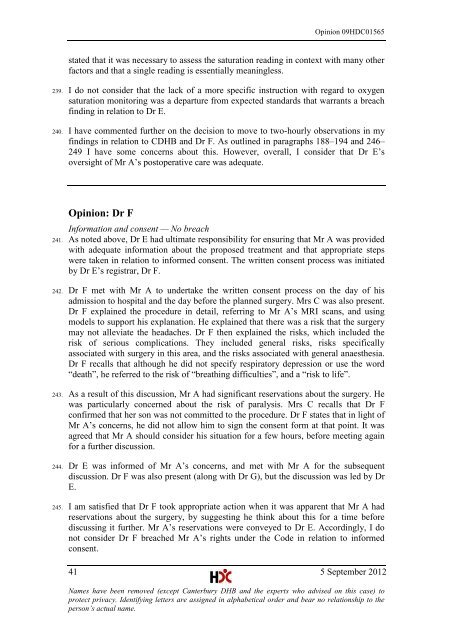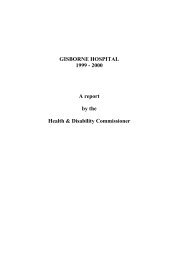09HDC01565 - Health and Disability Commissioner
09HDC01565 - Health and Disability Commissioner
09HDC01565 - Health and Disability Commissioner
You also want an ePaper? Increase the reach of your titles
YUMPU automatically turns print PDFs into web optimized ePapers that Google loves.
Opinion <strong>09HDC01565</strong><br />
stated that it was necessary to assess the saturation reading in context with many other<br />
factors <strong>and</strong> that a single reading is essentially meaningless.<br />
239. I do not consider that the lack of a more specific instruction with regard to oxygen<br />
saturation monitoring was a departure from expected st<strong>and</strong>ards that warrants a breach<br />
finding in relation to Dr E.<br />
240. I have commented further on the decision to move to two-hourly observations in my<br />
findings in relation to CDHB <strong>and</strong> Dr F. As outlined in paragraphs 188–194 <strong>and</strong> 246–<br />
249 I have some concerns about this. However, overall, I consider that Dr E‘s<br />
oversight of Mr A‘s postoperative care was adequate.<br />
Opinion: Dr F<br />
Information <strong>and</strong> consent — No breach<br />
241. As noted above, Dr E had ultimate responsibility for ensuring that Mr A was provided<br />
with adequate information about the proposed treatment <strong>and</strong> that appropriate steps<br />
were taken in relation to informed consent. The written consent process was initiated<br />
by Dr E‘s registrar, Dr F.<br />
242. Dr F met with Mr A to undertake the written consent process on the day of his<br />
admission to hospital <strong>and</strong> the day before the planned surgery. Mrs C was also present.<br />
Dr F explained the procedure in detail, referring to Mr A‘s MRI scans, <strong>and</strong> using<br />
models to support his explanation. He explained that there was a risk that the surgery<br />
may not alleviate the headaches. Dr F then explained the risks, which included the<br />
risk of serious complications. They included general risks, risks specifically<br />
associated with surgery in this area, <strong>and</strong> the risks associated with general anaesthesia.<br />
Dr F recalls that although he did not specify respiratory depression or use the word<br />
―death‖, he referred to the risk of ―breathing difficulties‖, <strong>and</strong> a ―risk to life‖.<br />
243. As a result of this discussion, Mr A had significant reservations about the surgery. He<br />
was particularly concerned about the risk of paralysis. Mrs C recalls that Dr F<br />
confirmed that her son was not committed to the procedure. Dr F states that in light of<br />
Mr A‘s concerns, he did not allow him to sign the consent form at that point. It was<br />
agreed that Mr A should consider his situation for a few hours, before meeting again<br />
for a further discussion.<br />
244. Dr E was informed of Mr A‘s concerns, <strong>and</strong> met with Mr A for the subsequent<br />
discussion. Dr F was also present (along with Dr G), but the discussion was led by Dr<br />
E.<br />
245. I am satisfied that Dr F took appropriate action when it was apparent that Mr A had<br />
reservations about the surgery, by suggesting he think about this for a time before<br />
discussing it further. Mr A‘s reservations were conveyed to Dr E. Accordingly, I do<br />
not consider Dr F breached Mr A‘s rights under the Code in relation to informed<br />
consent.<br />
41 5 September 2012<br />
Names have been removed (except Canterbury DHB <strong>and</strong> the experts who advised on this case) to<br />
protect privacy. Identifying letters are assigned in alphabetical order <strong>and</strong> bear no relationship to the<br />
person’s actual name.
















